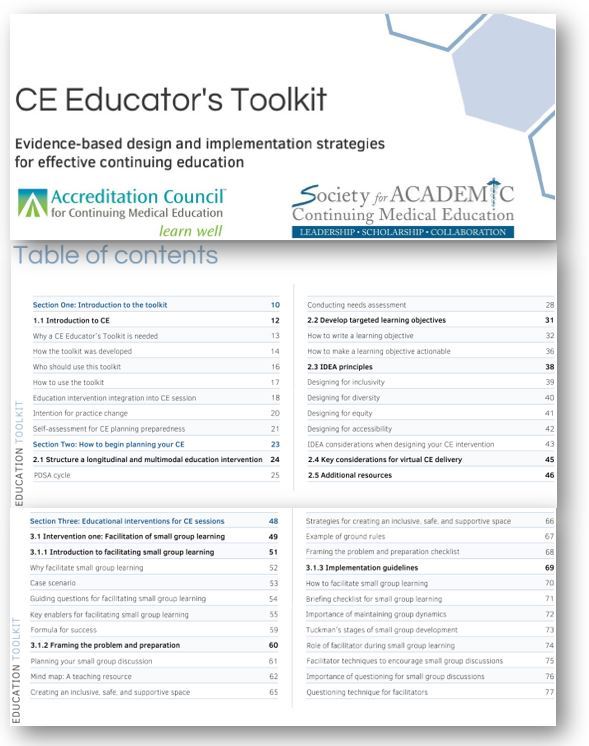CE Educator's Toolkit
SACME Research Team Completes CE Educator’s Toolkit—Now Available!
Reported by Robert D’Antuono, MHA
The CE Educator’s Toolkit, a unique educational resource, was developed by the Society for Academic Continuing Medical Education (SACME) through an Accreditation Council for Continuing Medical Education (ACCME) research grant in fulfillment of ACCME’s strategic goal to advocate for research and scholarship in continuing education. The toolkit is a unique and comprehensive resource designed to equip educators with best practices and guidelines to deliver effective continuing education (CE). The toolkit is now available and may be downloaded from the ACCME website or by clicking on the link below.
Research Project Team & Authors
We are grateful to the following SACME members for participating on the research team and for contributing their time and talents in creating the toolkit:
- Betsy Williams, PhD, MPH
- David Wiljer, PhD
- Joyce Fried, FSACME
- Gabrielle Kane, MB, EdD, FRCPC
- Sharon Ambata-Villanueva, MA, CTDP
- Ashleigh Jaggars, MPH
- Tharshini Jeyakumar, MHI
- Inaara Karsan, MHI
- Morag Paton, PhD, MEd
- Nathaniel Williams
- Sarah Younus, MPH
Overview
Clinical knowledge is continuously shifting the scope of practice and thus, significant gaps persist in translating evidence into practice to provide compassionate and high-quality care for patients. Current CE interventions are focused on instructor-oriented approaches and have been shown to be ineffective in fostering practice change. Inadequate education efforts can thwart the cultivation of knowledge and skills in ensuring practice decisions are rooted in evidence and aligned with current clinical standards. Accredited CE and faculty development are critical factors to promote a lifelong learning mindset of behavior change and practice improvement.
CE interventions for healthcare professionals are more effective when instructional methods promote critical thinking, collaboration, and decision-making skills. These methods improve team performance and encourage behavior change among healthcare professionals. In the absence of these methods, CE can be ineffective and feel unrewarding to learners. Therefore, educators should seek to evolve their educational programs to integrate principles of active learning and activities that promote engagement to make it more appealing for today's healthcare professional learners.
This toolkit aims to provide CE leaders, educators, and healthcare professionals with best practices and guidelines to assist in the design and delivery of CE in a manner that fosters a practical and active learning approach. Although there are different approaches to CE interventions, this toolkit will focus on three key interventions based on evidence-driven investigation and consultation with medical education experts: (1) facilitation of small group learning, (2) case-based learning, and (3) reflective learning.
The first section of the toolkit provides information about how the toolkit was developed and allows readers to complete a self-assessment to identify areas of the toolkit that might be relevant to their CE practice. Section 2 of the toolkit provides a matrix of essential components to consider when planning a CE intervention/activity. The subsequent section explores how to prepare and implement the three interventions selected for the toolkit: (1) facilitation of small group learning, (2) case-based learning, and (3) reflective learning. Section 4 in the toolkit is devoted to assessing and evaluating CE interventions with suggestions for various methods of evaluation. These essentials are discussed in extraordinary detail with instructional concepts and methods to plan, organize and implement each phase. To illustrate, Section 2 discusses:
I. First steps to education intervention design
- Structure a longitudinal and multimodal education intervention
- Use the PDSA cycle to structure your CE intervention
- Conduct a needs assessment to understand the audience and their learning needs
II. Learning Objectives
- Develop targeted learning objectives
- How to write a learning objective
- How to make a learning objective actionable
III. IDEA principles
- Designing for inclusivity
- Designing for diversity
- Designing for equity
- Designing for accessibility
- Checklist
IV. Virtual delivery
- Key considerations for virtual delivery
The toolkit was created for the novice and intermediate experience levels in CE development. However, this toolkit provides additional resources, planning templates, and helpful tips for those with advanced expertise in developing CE activities.
Toolkit Use, Distribution and Suggested Citation
The toolkit may be used, distributed, or presented for non-promotional educational purposes with attribution:
Accreditation Council for Continuing Medical Education. 2022. CE Educator’s Toolkit: Evidence-based design and implementation strategies for effective continuing education. http://www.accme.org/ceeducatorstoolkit

